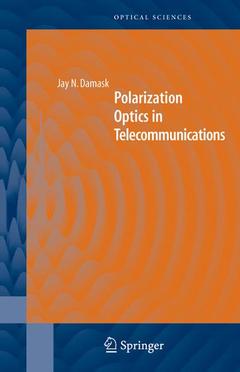Description
Polarization Optics in Telecommunications, 2005
Springer Series in Optical Sciences Series, Vol. 101
Author: Damask Jay N.
Language: English
Subject for Polarization Optics in Telecommunications:
Keywords
Dispersion; communication; electromagnetism; optics; polarization; telecommunications
Polarization Optics in Telecommunications
Publication date: 11-2010
522 p. · 15.5x23.5 cm · Paperback
Publication date: 11-2010
522 p. · 15.5x23.5 cm · Paperback
Polarization optics in telecommunications, (Series in optical sciences, Vol. 101)
Publication date: 11-2004
522 p. · 15.5x23.5 cm · Hardback
Publication date: 11-2004
522 p. · 15.5x23.5 cm · Hardback
Description
/li>Contents
/li>Comment
/li>
I have written this book to ?ll a void between theory and practice, a void that Iperceivedwhileconductingmyownresearchanddevelopmentofcomponents and instruments over the last ?ve years. In the chapters that follow I have pulled materials from the technical and patent literature that are relevant to the understanding and practice of polarization optics in telecommuni- tions, material that is often known by the respective experts in industry and academia but is rarely if ever found in one place. By bringing this material intoonemonograph,andbyapplyingasingleformalismthroughout,Ihopeto create a ?base level? upon which future research and development can grow. Polarization optics in telecommunications is an ever-evolving ?eld. Each yearsigni?cantadvancementsaremade,punctuatedbyimportantdiscoveries. The references upon which this book is based are only a snap-shot in time. Areasthatremainunresolvedatthetimeofpublicationmayverywellbecl- i?ed in the years to come. Moreover, the focus of the ?eld changes in time: for instance, there have been few passive nonreciprocal component advancements reported in the last few years, but PMD and PDL advancement continues with only modest abatement.
Vectorial Propagation of Light.- The Spin-Vector Calculus of Polarization.- Interaction of Light and Dielectric Media.- Elements and Basic Combinations.- Collimator Technologies.- Isolators.- Circulators.- Properties of Polarization-Dependent Loss and Polarization-Mode Dispersion.- Statistical Properties of Polarization in Fiber.- Review of Polarization Test and Measurement.
The strong investments into optical telecommunications in the late 1990s resulted in a wealth of new research, techniques, component designs, and understanding of polarization effects in fiber. Polarization Optics in Telecommunications brings together recent advances in the field to create a standard, practical reference for component designers and optical fiber communication engineers. Beginning with a sound foundation in electromagnetism, the author offers a dissertation of the spin-vector formalism of polarization and the interaction of light with media. Applications discussed include optical isolators, optical circulators, fiber collimators, and a variety of applied waveplate and prism combinations. Also included in an extended discussion of polarization-mode dispersion (PMD) and polarization-dependent loss (PDL), their Includes supplementary material: sn.pub/extras
© 2024 LAVOISIER S.A.S.
These books may interest you

Multi-dimensional Optical Storage 105.49 €



